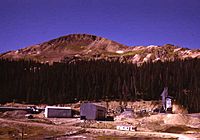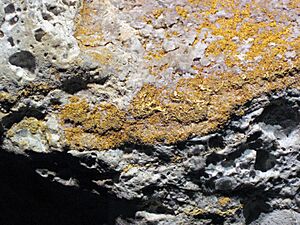Summitville mine facts for kids
Quick facts for kids Summitville mine |
|
|---|---|
| Superfund site | |

Summitville mine site in 1980
|
|
| Geography | |
| Town | Del Norte |
| County | Rio Grande |
| State | Colorado |
| Coordinates | 37°26′10″N 106°35′52″W / 37.43611°N 106.59778°W |
| Information | |
| CERCLIS ID | COD983778432 |
| Contaminants | Heavy metals |
| Responsible parties |
EPA |
| Progress | |
| Proposed | 05/10/1993 |
| Listed | 05/31/1994 |
| List of Superfund sites | |

The Summitville mine was a gold mining site in the United States. It was located in Rio Grande County, Colorado, about 25 miles (40 km) south of Del Norte. This mine is known for the environmental problems it caused in the 1980s. Mining waste leaked into local rivers, especially the Alamosa River.
Contents
What is the History of the Summitville Mine?
Early Gold Discoveries and Mining
In 1860, a group of gold seekers led by Charles Baker found small amounts of gold in the San Juan Mountains. They were near a place called Eureka, Colorado. However, the Ute Tribe made them leave in 1861. This area was part of a treaty with the Ute Tribe.
Later, in 1871, more gold was found in a vein called Little Giant. This was near Silverton, Colorado. Miners were allowed to stay after a new treaty in 1873. The Ute Tribe gave up 4 million acres of land. In return, they received $25,000 each year.
More gold veins were found in 1873 at 11,500 feet (3,500 m) high on South Mountain. The town of Summitville started when mills were built to process the gold.
Mining Operations and Challenges
By 1885, over 250 different mining claims were active. But the gold was soon mined out. The very high altitude and bad weather also made mining difficult. The mine was opened again several times for gold or other metals, but with little success. Before 1984, the last time anyone looked for metals there was in the early 1970s for copper. From 1873 to 1959, about 257,600 troy ounces (8,012 kg) of gold were taken from the site.
Modern Mining and Environmental Issues
In 1984, a company called Summitville Consolidated Mining Company, Inc. (SCMCI) bought about 1,230 acres (5 km²) of land. This company was a part of Galactic Resources Ltd. from Canada. They started a new, very large open-pit mine covering 550 acres (2.2 km²). They used new methods to get gold from ore that was not very rich in gold.
This mining method used a solution of sodium cyanide to get gold out of the rock. This process is called heap leaching. The liquid with gold was then taken out, and the gold was collected using activated carbon. SCMCI processed about 10 million tons of ore on a 73-acre (0.3 km²) heap leach pad.
Mining stopped in October 1991, but the leaching continued until March 1992. Then, Galactic Resources went bankrupt. They closed the site and started to clean up the stored water. About 160 million U.S. gallons (610,000 m³) of water needed treatment.
After the company went out of business, the U.S. Government declared Summitville a Superfund cleanup site. They spent $155,000,000 of public money to clean up the area.
What Happened After the Mine Closed?
Orders to Stop and Cleanup Efforts
In 1991, the state government told SCMCI to stop their operations. They were worried about high metal levels in nearby water. This was because water was leaking from the heap leach pad. About 85,000 U.S. gallons (320 m³) of contaminated water might have leaked into nearby streams.
In December 1992, Galactic Resources Ltd. declared bankruptcy. They announced that all cleanup work would stop right away. The United States Environmental Protection Agency (EPA) took over the cleanup from 1994. This was done under a special program called Superfund Emergency Response.
The biggest problem was the contaminated water held in a poor pond system. Water also leaked from older underground mine tunnels. The EPA estimated that 3,000 U.S. gallons (11 m³) were leaking every minute. Even though the water was very acidic (with a pH of about 3), a study by the United States Geological Survey (USGS) said the leakage was not a serious threat.
Costs and Environmental Impact
About $155 million was spent to clean up the site and stop the leaks. Robert Friedland, who was the chairman of Galactic Resources Ltd., paid about $30 million as part of a settlement.
It is thought that heavy metals and acid from the mine killed fish in reservoirs downstream on the Alamosa River in 1990. Cyanide also leaked from the mine. However, experts believe the cyanide quickly evaporated into the air. This means it probably did not harm the fish or other water life downstream.
Is All Pollution from Mining?
Natural Pollution in the Area
The rocks in the Summitville area were naturally changed millions of years ago. This process makes the streams in the area naturally acidic and high in metals. The names of nearby creeks show this natural water quality: Iron Creek, Alum Creek, and Bitter Creek.
Mining at Summitville made the problem worse. It exposed more rock surfaces to the weather. This increased the acid and metal levels in the water running off the mine area. The water quality problems at Summitville come from both old mining structures and the open-pit mining from 1985–1992.
Studies on Water Quality and Farming
Water from the Summitville mine flows down Wightman Fork. It then mixes with naturally acidic water from areas that were not mined. This water flows into the Alamosa River and then into the San Luis Valley. Farmers in the valley use this river water to irrigate their crops.
A study by the United States Geological Survey found three main things:
- Very acidic water draining from the rocks is the biggest long-term problem at the Summitville mine. This problem could have been predicted because of the type of rocks there. A lot of cleanup work is needed to protect the rocks and metal salts from weather and water.
- It is likely that natural pollution affected the water quality and fish in the Alamosa River long before mining started. It will continue to affect them even after the mine is cleaned up. So, we need to understand the natural conditions of the Alamosa River to set realistic cleanup goals for Summitville.
- Studies from late 1993 showed that mining at Summitville had no clear short-term bad effects on barley or alfalfa crops. These crops were irrigated with Alamosa River water. Cleaning up the site will help make sure there are no bad effects in the long run.


